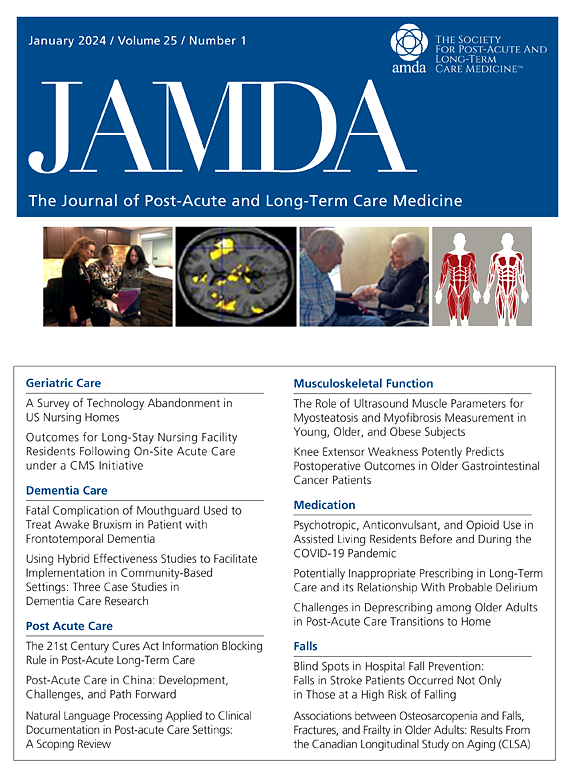养老院CMS质量星级评级变动频繁:2009 - 2020年趋势的描述性分析
IF 4.2
2区 医学
Q2 GERIATRICS & GERONTOLOGY
Journal of the American Medical Directors Association
Pub Date : 2025-06-03
DOI:10.1016/j.jamda.2025.105631
引用次数: 0
摘要
目的:养老院比较星级评级密切关注医院交付系统,政策制定者和消费者的护理质量的措施。然而,对于养老院能够或确实在星级评级之间移动的程度,我们所知甚少,我们称之为绩效流动性。本研究通过研究整体养老院星级评级的流动性趋势,解决了文献中的空白。设计:描述性分析。环境和参与者:我们审查了16,568家美国医疗保险认证疗养院的2,016,985个月度评分。方法:使用医疗保险和医疗补助服务中心(CMS)养老院比较数据,我们构建了2009年1月至2020年2月美国每家养老院每月总体星级评分的数据库。我们首先分析了疗养院在一段时间内接受每一种评级的比例,然后进行了对流动性的3个重点分析,包括(1)流动性的频率,(2)每种流动性组合的中位数过渡时间,以及(3)单一单位评级变化的趋势。结果:从2009年到2020年,我们观察到总体评级呈上升趋势,尽管质量要求更严格,评级之间的上下浮动频繁:40.32%的一星级养老院后来获得了五星级评级,而27.97%的五星级养老院后来获得了一星评级。当这些极端之间的变化发生时,他们对结论和含义取平均值:我们的研究结果表明养老院的五星级评级变化频繁且迅速。绩效在患者选择疗养院时扮演关键角色,我们的研究结果建议进一步研究这些变化的前因和影响。本文章由计算机程序翻译,如有差异,请以英文原文为准。
CMS Quality Star Ratings for Nursing Homes Change Frequently: A Descriptive Analysis of Trends From 2009 to 2020
Objectives
Nursing Home Compare star ratings are closely watched by hospital delivery systems, policymakers, and consumers as measures of care quality. However, very little is known about the degree to which nursing homes can or do move between star ratings, what we refer to as performance mobility. This study addresses a gap in the literature by examining mobility trends in overall nursing home star ratings.
Design
Descriptive analysis.
Setting and Participants
We reviewed 2,016,985 monthly ratings for 16,568 unique US Medicare–certified nursing homes.
Methods
Using Centers for Medicare and Medicaid Services (CMS) Nursing Home Compare data, we constructed a database of the overall monthly star ratings for each nursing home in the United States from January 2009 through February 2020. We began by trending the proportion of nursing homes receiving each rating over time before proceeding to 3 focused analyses on mobility, including (1) the frequency of mobility, (2) the median transition time for each mobility combination, and (3) trends in single-unit changes in rating.
Results
From 2009 to 2020, we observed a general upward trend in overall ratings despite stricter quality requirements, and frequent mobility—both upward and downward—between ratings: 40.32% of 1-star nursing homes later received a 5-star rating, whereas 27.97% of 5-star nursing homes later received a 1-star rating. When these changes between extremes occurred, they took an average of <5 years.
Conclusions and Implications
Our findings suggest that nursing home 5-star ratings change frequently and quickly. Performance plays a key role in nursing home selection among patients, and our results suggest that further studies should examine the antecedents and impacts of such changes.
求助全文
通过发布文献求助,成功后即可免费获取论文全文。
去求助
来源期刊
CiteScore
11.10
自引率
6.60%
发文量
472
审稿时长
44 days
期刊介绍:
JAMDA, the official journal of AMDA - The Society for Post-Acute and Long-Term Care Medicine, is a leading peer-reviewed publication that offers practical information and research geared towards healthcare professionals in the post-acute and long-term care fields. It is also a valuable resource for policy-makers, organizational leaders, educators, and advocates.
The journal provides essential information for various healthcare professionals such as medical directors, attending physicians, nurses, consultant pharmacists, geriatric psychiatrists, nurse practitioners, physician assistants, physical and occupational therapists, social workers, and others involved in providing, overseeing, and promoting quality

 求助内容:
求助内容: 应助结果提醒方式:
应助结果提醒方式:


